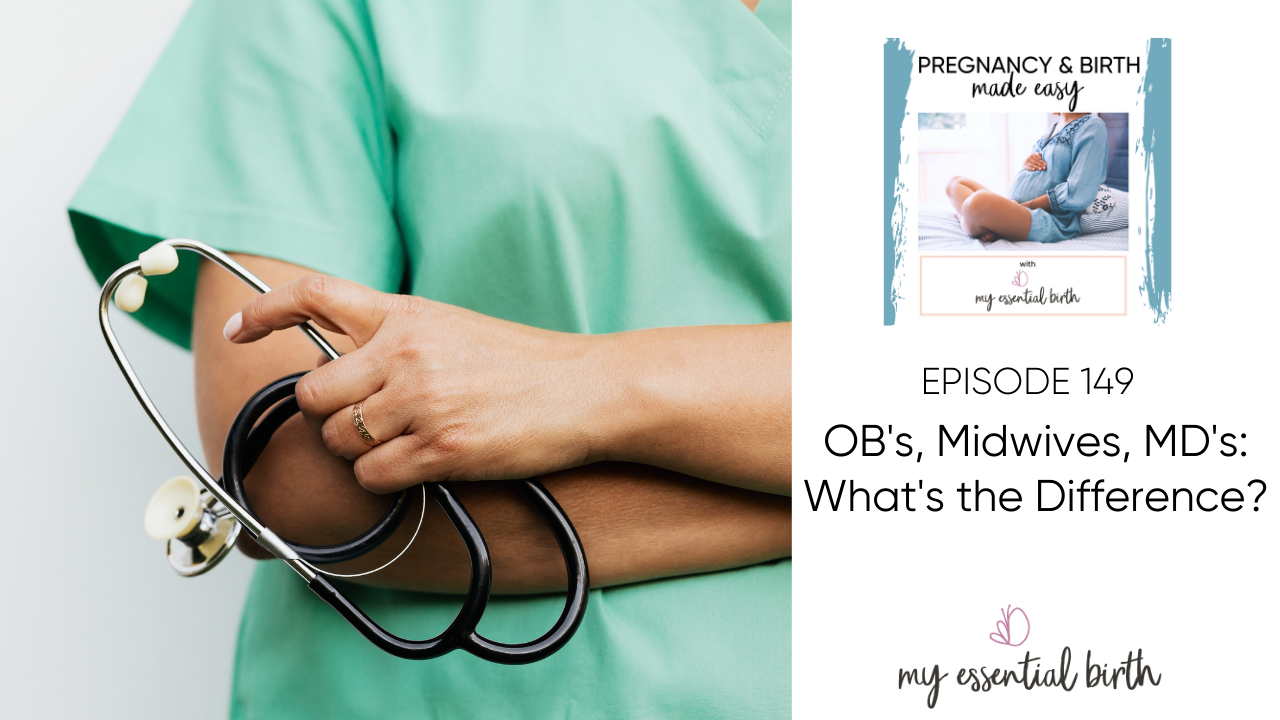
OB's, Midwives, MD's: What's the Difference?
OB’s and MD’s and Midwives, oh my! 😏 We’re going to talk about the training, certification, and background each of these providers is required to have in order to practice. Maybe you’re like me, and once upon a time, I thought OB’s were the only option when it came to a provider for your birth experience. 😆 My goal is for you to know what your options are so you can choose a provider based on the birth experience you want to achieve!
Show Notes:
[1:12] Jguar9, our reviewer of the week, says: “So thankful! I can’t say enough positive things about this podcast! Educational, organized, captivating, empowering, charming!” She is a mama at the end of pregnancy number five and feeling equipped for labor and delivery! She is thankful to My Essential Birth for providing a much needed resource and changing other mama’s worlds and birth stories. 💕
Quick commercial break. 😉 Have you left us a review yet? This is the #1 way to say thank you, this is awesome, or you want others to find the podcast! I read every single one!
I was three pregnancies in before I felt equipped and like I knew what I was doing when it came to labor. It was my first unmedicated birth, and even afterwards, I felt like there was so much to learn about birth, the process, my body, and myself! 💜
[2:48] When I was pregnant with my first baby, I had no idea that there was anything other than an obstetrician. I’m sure I’m not alone in this! 🤷🏼♀️ An obstetrician might be a great option for you, but you should get to choose! (You guys know how I feel about that, no need to get on my soap box about it. 🗣)
[3:30] In the United States, once you have a menstrual cycle, you’re sent to an obstetrician. Since they also deliver babies, it was this natural progression to go from an OB to an OB when you have your baby. It wasn’t until I took a birth course that I learned about midwives!
[4:35] I share a little bit about my birth experiences with my three boys. I had a Cesarean birth, a midwife-assisted delivery which was a VBAC, and finally a home birth! I also talk about my experience with trying to find a midwife once we moved stateside again. (I was shocked and a little embarrassed!) 🤦🏼♀️😳
[7:42] So in case you’re wondering what the difference is between all of these providers who can attend your birth, keep listening!
[8:16] Let’s start with the obstetrician. 👩🏻⚕️ This is an individual who has taken special training to care for women before, during, and after pregnancy. They also deal with any surgeries prenatal (dilation and curettage or a D&C) or postpartum (tubal litigation, hysterectomy, etc.).
[9:23] We talk about the degrees, licensing, certifications, and testing required to become an obstetrician. It all adds up to 12 years of experience!
[11:28] Something I want to emphasize is that obstetricians take a lot of time during their residencies doing surgeries. With that, Cesarean births are a huge part of what they’re learning and practicing during their residency. Some obstetricians are required to perform up to 200 cesarean births within their 3-4 years of residency. 🤯😱 Which brings me back to how I strongly believe Cesarean births are pushed way too much in the U.S.
[13:25] As a side note, just because a provider is required to perform a certain amount of surgeries or Cesareans for their trainings, it doesn’t mean that is how they will practice. I do think it gives them a more medical eye and makes them more prone to see and practice things a certain way. 📈
[14:03] I talk about how an obstetrician may tend to view birth and labor progression versus a midwife. 🩺
[15:58] Did you know medical doctors (without an OB specialty) can attend births? I’m talking about your family physician! I talk about what the certification, licensure, and training requirements are for family physician care. It is about 12 years of education/experience.
[18:58] Next up: CNM’s (certified nurse midwives) in a hospital setting! 🏥 They focus on gynecology and family planning services (birth control, hormones, etc.) They can order ultrasounds, provide primary care and annual examinations (breast exam, Pap smears), offer nutrition counseling, write prescriptions, etc. They cannot perform Cesareans!
[20:14] We talk about certified nurse midwives training, degrees, experience, and examinations. It’s about 8 years of schooling and extremely specific to working with pregnant women in a hospital setting. 🤰🏼
[22:08] A CNM (certified nurse midwife) who works out of a hospital setting has had all the same training as the in-hospital midwife, but they choose to work out of hospital. In 22 states, a CNM must be overseen by a licensed physician. 🤝
[24:11] Let’s discuss Midwives and their different classifications and duties. We talk about the training they receive as well.
- CPM (certified professional midwife)
- DEM (direct entry or a traditional midwife)
- LDEM (licensed direct entry midwife)
[30:50] I hope this episode has been helpful. You may need to go back and listen to it again! My goal is for you to understand the training and background that is needed for each provider and what will mix well with you and what your needs are. ✨
[32:01] I want to emphasize again that the people who are trained medically are more likely going to want medical procedures/intervention for mom and baby because that is what their background has conditioned them to see. 👀 Which may be comforting to know for some moms! You now have a choice on what sounds right for you! 🤔
To Leave a Review ⭐️
1. Open Apple Podcasts
2. Find “Pregnancy & Birth Made Easy” podcast
3. Select “Ratings and Reviews”
4. Click the stars!
5. Select “Write a Review” and tell us what was the most amazing, comforting, eye-opening thing that you loved!
ALL the best,

Links Mentioned:



